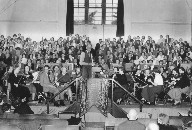| |
 
A FORGOTTEN
COMPOSER REVIVED
 |
|
1066, 1415 and
1588, three dates that are, or at any
rate were at one time, engraved on the
brain of every schoolchild. The
middle one might possibly cause the most
trouble, yet it is perhaps the most
relevant to us living in Petersfield. The
Battle of Agincourt has been immortalised
in Shakespeare’s words and on film
by Lawrence Olivier and Kenneth
Brannagh., and one of Henry V’s top
generals lived close by, at
Trotton. Lord Thomas Camoys,
who commanded the left wing at the
battle, was responsible for building the
famous bridge and lies buried in the
church. His tomb is marked by
a huge brass depicting him in full
armour, holding his wife’s hand,
with the Order of the Garter below his
left knee.
it was perhaps this local
connection that inspired Sir George Dyson
to compose his cantata, Agincourt, when
commissioned by the Petersfield Musical
Festival to write a work for its Golden
Jubilee in 1956, a work which is being
revived at this year’s Festival. |
Dyson was a
Yorkshireman, born in Halifax in 1883, and won an
Open Scholarship to the Royal College of Music at
the age of seventeen. After study
abroad and war service, during which he became an
acknowledged authority on grenade warfare, he
became the voice of public school music.
It was during his time as Director of Music
at Winchester College, from 1924 until 1937, that
he achieved greatest fame as a
composer. Practical experience with
choirs in the district inspired him to compose
works like In Honour of the City in 1928 and The
Canterbury Pilgrims in 1931. Later,
for the Three Choirs Festival, he wrote
Nebuchadnezzar and Quo Vadis and contributed
anthems for the Coronations of 1937 and 1953.
In 1935 he became the first President of
the National Federation of Music Societies and
was appointed Director of the Royal College of
Music in 1939 and knighted in 1941. During this
time he wrote his Symphony and Violin Concerto,
and he continued to compose vocal and
instrumental works until, and beyond, his
retirement from the College in 1953, in a style
which chose steadfastly to ignore the fact the
music in post-war Britain had moved on.
Dyson was a prolific composer of part
songs, and it was these which first brought his
music to the Petersfield Festival.
From 1927 until 1964 scarcely a year went by
without one of his works being included as a
competition piece, often for women’s voices
alone.
But it was not until after the war that any
of his major works were heard here, and the new
Festival Conductor, Dr. Sidney Watson, was
obviously a great devotee. In only
his second year in the post, 1947, he introduced
Dyson’s best known cantata, The Canterbury
Pilgrims, followed five years later by
Hierusalem. In 1954 he directed In
Honour of the City, and such was Dyson’s
popularity that the Festival commissioned a new
work from him, Agincourt, which the composer
himself conducted.
In 1960 Dyson, by now in his late
seventies, attended a performance of The
Canterbury Pilgrims at Churcher’s College,
conducted by T. Warden Lane, with Wilfred Brown
and Norman Tattersall among the soloists.
In those days Tim Lane was Mr Music in
Petersfield and as well as teaching at the
College, he was Organist at St. Peter’s
Church, Musical Director of the Petersfield
Operatic Society and, from 1945 until 1981,
conductor of the Petersfield Choral
Society. He served on the Festival
Committee during the same period and became
President in 1983, dying in the following year.
After Dyson’s death in 1964, his
music, a handful of church services apart, fell
into almost total neglect. Here in
Petersfield, however, Richard Seal revived
Hierusalem in 1977 and Bill Llewellyn conducted
Three Songs of Praise in 1990, the latter
sounding, to these ears at least, very
dated. From the mid-1980s, sparked by
the enthusiasm of the late Christopher Palmer and
subsequently spearheaded by the Sir George Dyson
trust, there has been a substantial resurgence of
interest, which has seen the recording of
virtually all Dyson’s main works, including
Agincourt.
There may be a few singing in this year’s
Festival who remember Agincourt from fifty years
ago, but for many of us it will be new, and it
will be interesting to hear how strongly the
creative flame was still burning in this, one of
his last works.
Tom Muckley, January 2008
This article was originally
published by the
Petersfield Post
tommuckley.co.uk
|
|


